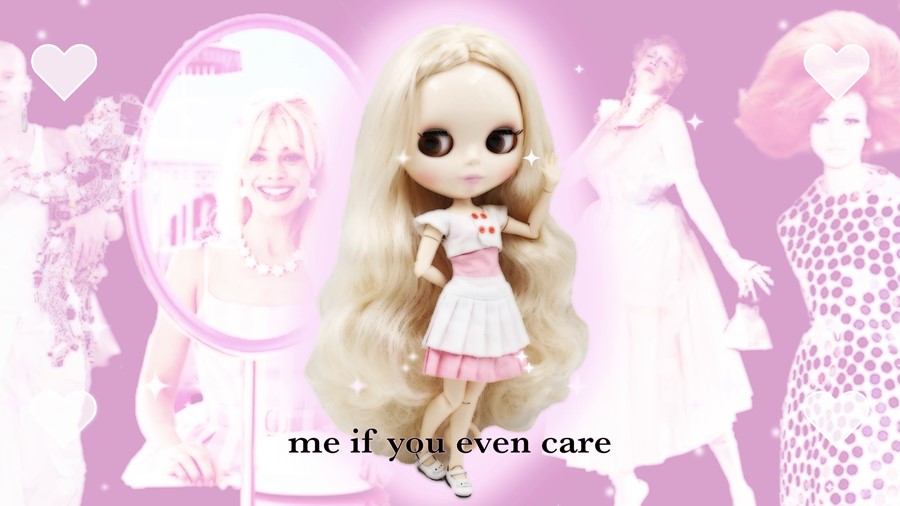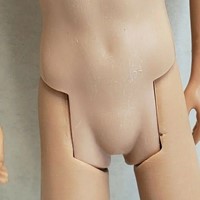From Barbie to Blythe dolls, Margiela to Marc Jacobs, dolls are spilling out from our screens and onto fashion runways. Enter the dollhouse at your own risk
The internet is a dollhouse. It began last year when people began posting clear-pilled memes featuring Blythe Dolls – those creepy dolls with oversized heads and bug eyes that change colour with a pull string. The images began circulating hyper-online circles, where users with anime and IMVU avatars shared girl-coded content with captions like, “me if you even care ౨ৎ”, garnering thousands of likes, before multiplying across socials as independent fashion drops and underground zines, and eventually reaching the feeds of New York’s Downtown kids, with it-girls sharing their AI-generated miniatures on Instagram. There’s even a subreddit, r/BlytheDolls, where users trade tips on how to create your own ultra-cute version (pink satin bows are optional).
Doll-mania has also been the focus of recent runways – most notably in Margiela’s spectacular SS24 couture show, where John Galliano’s living porcelain dolls tottered down the catwalk. The show notes described the collection as “a study of the muse-like relationship between artists and their anatomical lay dolls”. Then there’s Marc Jacobs’ New York show, featuring models seemingly shrunken down to diminutive Blythe proportions, with their clothes reminiscent of paper dolls. Not to be confused with Schiaparelli sending a model down the runway clutching a baby made from discarded tech: cell phones, circuit boards and charging cables. (Technically not a doll, but raises an interesting question about the nature of human-machine relationships: the point is that technology is no longer an object to be used but a subject to be cared for – nurtured, even.)
But what if I were to tell you that the case for doll supremacy is only getting bigger? Whether it’s the viral discourse around Greta Gerwig’s Barbie, the highest-grossing film of last year, or the hot girl obsession with subliminals, my feed is littered with dolls. “Ur eyes are like a doll,” flashes one subliminal message on Tiktok, while another titled ‘D0LL-L1KE BE@UTY’ promises to make you the “sweetest of them all” to the heavenly score of ‘777’ angel numbers. Since the beginning of human history, dolls have been used as effigies to cast spells – from the poppet in European folk magic to voodoo dolls – so it’s no surprise to find this play out within hyper-niche corners of the internet, where some users believe dolls are a form of divine beings whose divinity has been ritualistically excised from them. The endgame is ‘angelic dissolution’ – basically, stop thinking, be a doll.
Before we get any deeper into the intricacies of internet doll-speak, let’s break it down into its doll parts. As objects, dolls appear cute, unserious and inconsequential – all appealing qualities in an overwhelming and complicated world plagued by very serious things such as censorship, surveillance, rising costs and radicalisation. “With girl-coded trends, doll memes, symbols, and fashion feels linked into a wider moment of revisiting ‘girlhood’ – whether as a dream, a cope, or a vent,” says theorist Alex Quicho. “Following the ubiquitous global ad that was the Barbie movie, dolls – as in, the literal toys – appear again as vessels for channelling old-school questions about gender roles and representation, innocence and agency, objectification and power.”
In The Second Sex, Simone de Beauvoir uses the imagery of the doll to describe the process by which a woman begins to see herself as an object of desire. Nowadays, it’s not enough to identify with the doll, but to become a literal doll through face filters and cosmetic procedures that cutify our proportions, leaving us child-like and blemish-free. The uncanny valley make-up trend takes this a step further by making us appear robotic, doll-like and not-quite-human. This, as usual, is partly indebted to the actual dolls whose innovation has no doubt shaped pop culture – what’s Instagram Face or Bold Glamour if not an expansion of trans technologies? “How our own bodies are built and altered from the hormones up – or from the face down – owes a lot to decades of trans discourse and innovation,” agrees Quicho.
Sometimes I think of the way we present ourselves on social media: it’s as if we have our own individual Barbie boxes or ‘starter packs’, packaged as products with our own special interests, friends, lovers and locations. Even the way we consume culture, through algorithms that churn out micro-trends that encourage sameness, feels mass-produced, like how TikTok face creates the illusion of choice (‘what pretty are you?’) while encouraging us all to look the same. Or how the language we use online is absurd and robotic as per Pinkydoll. It feels like a conveyor belt pumping out versions of ourselves for digital consumption.
“Maybe we want a corporeal representation of the anthropomorphised AI we have around us the past few years” – Arvida Byström
As symbols of consumerism, dolls are what cute theorists Amy Ireland and Maya Kronic would refer to as “an avatar of commercial and artificial desire”, meaning they’re cute and ultra-compact, which enhances their mass appeal – think how quickly tiny satin bows, as ubiquitous to the doll aesthetic as Hello Kitty and anime girls, made the rounds across socials last year. But dolls, like puppets or automata, also suggest performativity, and parallel our own role as content creators performing for the feed.
Of all the artists exploring our warped relationship to social media, the most viral is the work of artist Anna Uddenberg, whose sculptures of doll-like figures – sexualised female forms that appear faux synthetic and mutant – twist and contort into uncomfortable shapes that reflect our own on-screen addictions. And then there’s choreographer Candela Capitan, whose performers hang limp from chains on a rig that keeps them literally locked to their phones, their faces illuminated by a bright white phone light. In a recent performance, dancers even live-streamed the show direct to TikTok, in case we need any more reminders of how deeply interconnected our lives are to tech.
To be a doll means to have no agency. The same can be said for disembodied tech girlies Alexa and Siri – or virtual companion apps such as Replika and AI sex dolls. “The idea of a seemingly inert and inhuman girl-object continually reappears to trouble our relationship to all of these examples,” explains Quicho. Soaked in silicon and wires, these artificial women, and our relationship to them, highlights the relationship between women and technology, while casting an artificial mirror to reflect our deepest emotional needs, such as love and companionship. “Maybe we want a corporeal representation of the anthropomorphised AI we have around us the past few years,” suggests Arvida Byström, a Swedish-born multidisciplinary artist whose A Cybernetic Doll’s House sees her perform with an AI sex doll replica, Harmony.
To roam the uncanny valley of the dolls is an inevitable part of our ongoing virtualisation as the line between man and machine dissolves completely. Just this month Apple launched its Vision Pro headset and Elon Musk’s Neuralink is conducting human trials, which seems meme-worthy now, but will likely be absorbed into the everyday, especially as tech becomes sentient, and our emotional bond towards machines grows stronger. It’s an ironic twist that the dolls are beginning to appear more human-like, while we humans are starting to resemble dolls, though none of that will matter in the future – we’re all desiring machines anyway, all we need to do is scratch the surface to expose its mutant core.




